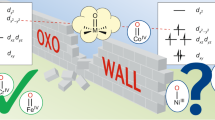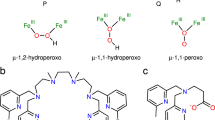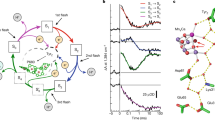Abstract
The electrons that nature uses to reduce CO2 during photosynthesis come from water oxidation at the oxygen-evolving complex of photosystem II. Molecular catalysts have served as models to understand its mechanism, in particular the O–O bond-forming reaction, which is still not fully understood. Here we report a Ru(iv) side-on peroxo complex that serves as a ‘missing link’ for the species that form after the rate-determining O–O bond-forming step. The Ru(iv) side-on peroxo complex (η2-1iv–OO) is generated from the isolated Ru(iv) oxo complex (1iv=O) in the presence of an excess of oxidant. The oxidation (iv) and spin state (singlet) of η2-1iv–OO were determined by a combination of experimental and theoretical studies. 18O- and 2H-labelling studies evidence the direct evolution of O2 through the nucleophilic attack of a H2O molecule on the highly electrophilic metal–oxo species via the formation of η2-1iv–OO. These studies demonstrate water nucleophilic attack as a viable mechanism for O–O bond formation, as previously proposed based on indirect evidence.

This is a preview of subscription content, access via your institution
Access options
Access Nature and 54 other Nature Portfolio journals
Get Nature+, our best-value online-access subscription
$29.99 / 30 days
cancel any time
Subscribe to this journal
Receive 12 print issues and online access
$259.00 per year
only $21.58 per issue
Buy this article
- Purchase on Springer Link
- Instant access to full article PDF
Prices may be subject to local taxes which are calculated during checkout




Similar content being viewed by others
Data availability
The crystallographic data for η2-[Ruiv(OO)(Py2Metacn)](PF6)1.5(IO3)0.5, η2-[Ruiv(OO)(Py2Metacn)](PF6)2 and 1iv=O have been deposited with the Cambridge Crystallographic Data Centre under accession numbers 1944703, 1944703 and 1944705, respectively. The data supporting the findings of the current study are available within the paper and its Supplementary Information.
References
Cox, N., Pantazis, D. A., Neese, F. & Lubitz, W. Biological water oxidation. Acc. Chem. Res. 46, 1588–1596 (2013).
Lubitz, W., Chrysina, M. & Cox, N. Water oxidation in photosystem II. Photosynth. Res. 142, 105–125 (2019).
Field, C. B., Behrenfeld, M. J., Randerson, J. T. & Falkowski, P. Primary production of the biosphere: integrating terrestrial and oceanic components. Science 281, 237–240 (1998).
Lewis, N. S. Research opportunities to advance solar energy utilization. Science 351, aad1920 (2016).
Gersten, S. W., Samuels, G. J. & Meyer, T. J. Catalytic oxidation of water by an oxo-bridged ruthenium dimer. J. Am. Chem. Soc. 104, 4029–4030 (1982).
Zhang, B. & Sun, L. Artificial photosynthesis: opportunities and challenges of molecular catalysts. Chem. Soc. Rev. 48, 2216–2264 (2019).
Karkas, M. D., Verho, O., Johnston, E. V. & Akermark, B. Artificial photosynthesis: molecular systems for catalytic water oxidation. Chem. Rev. 114, 11863–12001 (2014).
Sartorel, A. et al. Polyoxometalate embedding of a tetraruthenium(iv)-oxo-core by template-directed metalation of [γ-SiW10O36]8−: a totally inorganic oxygen-evolving catalyst. J. Am. Chem. Soc. 130, 5006–5007 (2008).
Pantazis, D. A. Missing pieces in the puzzle of biological water oxidation. ACS Catal. 8, 9477–9507 (2018).
Blakemore, J. D., Crabtree, R. H. & Brudvig, G. W. Molecular catalysts for water oxidation. Chem. Rev. 115, 12974–13005 (2015).
Lloret-Fillol, J. & Costas, M. in Advances in Organometallic Chemistry Vol. 71 (ed. Pérez, P. J.) 1–52 (Academic, 2019).
Fukuzumi, S., Lee, Y.-M. & Nam, W. Kinetics and mechanisms of catalytic water oxidation. Dalton Trans. 48, 779–798 (2019).
Shaffer, D. W., Xie, Y. & Concepcion, J. J. O–O bond formation in ruthenium-catalyzed water oxidation: single-site nucleophilic attack vs. O–O radical coupling. Chem. Soc. Rev. 46, 6170–6193 (2017).
Gamba, I., Codolà, Z., Lloret-Fillol, J. & Costas, M. Making and breaking of the OO bond at iron complexes. Coord. Chem. Rev. 334, 2–24 (2017).
Wasylenko, D. J. et al. Electronic modification of the [Ruii(tpy)(bpy)(OH2)]2+ scaffold: effects on catalytic water oxidation. J. Am. Chem. Soc. 132, 16094–16106 (2010).
Concepcion, J. J., Tsai, M. K., Muckerman, J. T. & Meyer, T. J. Mechanism of water oxidation by single-site ruthenium complex catalysts. J. Am. Chem. Soc. 132, 1545–1557 (2010).
Kang, R., Yao, J., Chen, H. & Are, D. F. T. Methods accurate in mononuclear ruthenium-catalyzed water oxidation? An ab initio assessment. J. Chem. Theory Comput. 9, 1872–1879 (2013).
Duffy, E. M., Marsh, B. M., Voss, J. M. & Garand, E. Characterization of the oxygen binding motif in a ruthenium water oxidation catalyst by vibrational spectroscopy. Angew. Chem. Int. Ed. 55, 4079–4082 (2016).
Cramer, C. J., Tolman, W. B., Theopold, K. H. & Rheingold, A. L. Variable character of O–O and M–O bonding in side-on (η2) 1:1 metal complexes of O2. Proc. Natl. Acad. Sci. USA 100, 3635–3640 (2003).
Holland, P. L. Metal–dioxygen and metal–dinitrogen complexes: where are the electrons? Dalton Trans. 39, 5415–5425 (2010).
Company, A., Lloret-Fillol, J. & Costas, M. in Comprehensive Inorganic Chemistry II 2nd edn (eds Reedijk, J. & Poeppelmeier, K) 487–564 (Elsevier, 2013).
Cho, J. et al. Structure and reactivity of a mononuclear non-haem iron(iii)–peroxo complex. Nature 478, 502–505 (2011).
Bang, S. et al. Redox-inactive metal ions modulate the reactivity and oxygen release of mononuclear non-haem iron(iii)–peroxo complexes. Nat. Chem. 6, 934–940 (2014).
Fukuzumi, S. et al. Catalytic four-electron reduction of O2 via rate-determining proton-coupled electron transfer to a dinuclear cobalt-μ-1,2-peroxo complex. J. Am. Chem. Soc. 134, 9906–9909 (2012).
Polyansky, D. E. et al. Water oxidation by a mononuclear ruthenium catalyst: characterization of the intermediates. J. Am. Chem. Soc. 133, 14649–14665 (2011).
Wang, L., Wu, Q. & Voorhis, T. V. Acid−base mechanism for ruthenium water oxidation catalysts. Inorg. Chem. 49, 4543–4553 (2010).
Casadevall, C., Codolà, Z., Costas, M. & Lloret-Fillol, J. Spectroscopic, electrochemical and computational characterisation of Ru species involved in catalytic water oxidation: evidence for a [Ruv(O)(Py2Metacn)] intermediate. Chem. Eur. J. 22, 10111–10126 (2016).
Shen, J., Stevens, E. D. & Nolan, S. P. Synthesis and reactivity of the ruthenium(ii) dihydride Ru(Ph2PNMeNMePPh2)2H2. Organometallics 17, 3875–3882 (1998).
Cho, J., Sarangi, R. & Nam, W. Mononuclear metal–O2 complexes bearing macrocyclic N-tetramethylated cyclam ligands. Acc. Chem. Res. 45, 1321–1330 (2012).
Savini, A. et al. Mechanistic aspects of water oxidation catalyzed by organometallic iridium complexes. Eur. J. Inorg. Chem. 2014, 690–697 (2014).
Acknowledgements
We thank the ICIQ Foundation, MEC for PhD grants FPU14/02550 (C.C.) and FPU16/04234 (S.F.), and for the AP2Chem project (Ref: PID2019-110050RB-I00), the European Research Foundation for project FP7-PEOPLE-2010-ERG-268445 (J.L.-F.) and the CELLEX Foundation through the CELLEX-ICIQ high-throughput experimentation platform, the Netherlands Ministry of Education, Culture and Science (Gravity Program 024.001.035, W.R.B.) for financial support. We acknowledge Catexel for the generous gift of 1,4,7-tritosyl-1,4,7-triazacyclononane (Ts3tacn). We acknowledge the LUCIA Beamline staff at SOLEIL synchrotron where the XAS data was collected (V.M.-D.).
Author information
Authors and Affiliations
Contributions
J.L.-F. and C.C. directed and conceived this project. C.C. synthesized all the intermediates, performed most of the experimental work, the DFT studies, the kinetic model and wrote the draft of the manuscript. V.M.-D., C.C., F.F. and B.L.-K. performed the synchrotron measurements and V.M.-D. analysed the data. W.R.B. and C.C. performed the Raman measurements and the analyses. V.M.-D. and C.C. performed the electron spin resonance experiments. S.F. performed the studies to calculate the activation parameters. C.C. and F.F. performed the electrochemical studies. N.C. optimized the experimental parameters of CSI-HRMS and, together with C.C., performed the CSI-HRMS studies and analysed the data. J.B.-B. performed the crystallographic analyses of the isolated intermediates. All the authors discussed the results and contributed to the manuscript.
Corresponding author
Ethics declarations
Competing interests
The authors declare no competing interests.
Additional information
Peer review information Nature Chemistry thanks the anonymous reviewers for their contribution to the peer review of this work.
Publisher’s note Springer Nature remains neutral with regard to jurisdictional claims in published maps and institutional affiliations.
Supplementary information
Supplementary Information
Supplementary Figs. 1–89, Schemes 1–3, Tables 1–15, discussion and references.
Supplementary Data 1
DFT cartesian coordinates for all calculated geometries, DFT optimized structures 1−46.
Supplementary Data 2
Crystallographic data for η2-[Ruiv(OO)(Py2Metacn)](PF6)1.5(IO3)0.5 CCDC reference 1944703.
Supplementary Data 3
Crystallographic data for η2-1iv–OO CCDC reference 1944704.
Supplementary Data 4
Crystallographic data for 1iv=O CCDC reference 1944705.
Rights and permissions
About this article
Cite this article
Casadevall, C., Martin-Diaconescu, V., Browne, W.R. et al. Isolation of a Ru(iv) side-on peroxo intermediate in the water oxidation reaction. Nat. Chem. 13, 800–804 (2021). https://doi.org/10.1038/s41557-021-00702-5
Received:
Accepted:
Published:
Issue Date:
DOI: https://doi.org/10.1038/s41557-021-00702-5
This article is cited by
-
Efficient water oxidation under mild alkaline conditions with ruthenium(IV)-iron(VI) catalysts
Environmental Chemistry Letters (2024)
-
Understanding and prediction of metastable single-layer metallene oxides
Science China Materials (2023)



